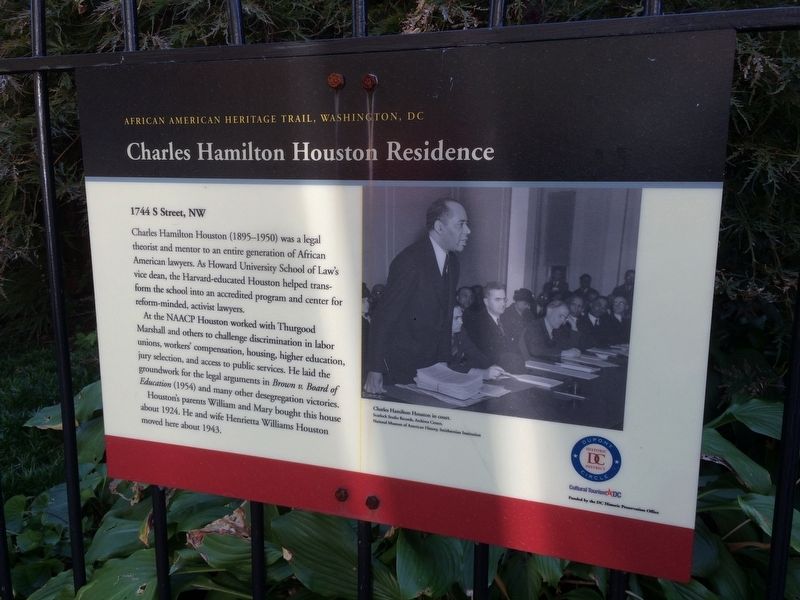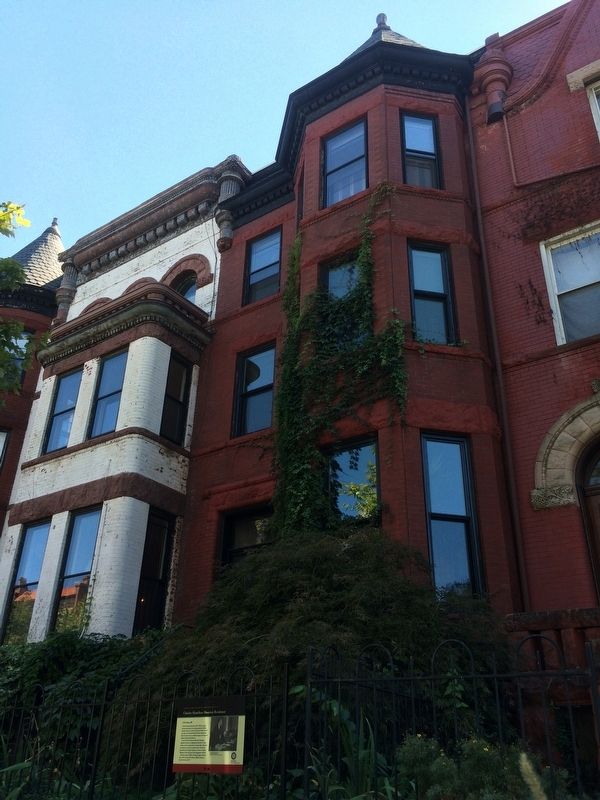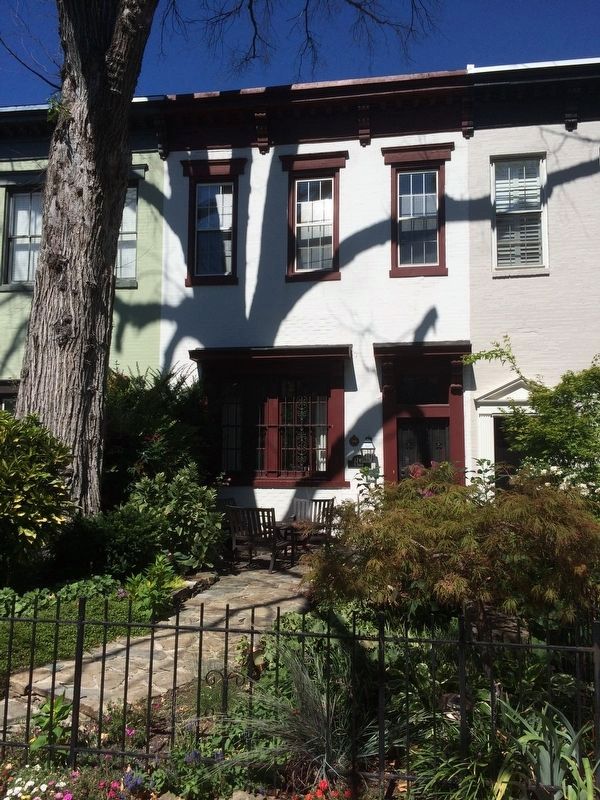Dupont Circle in Northwest Washington in Washington, District of Columbia — The American Northeast (Mid-Atlantic)
Charles Hamilton Houston Residence
1744 S Street, NW
— African American Heritage Trail, Washington DC —
Charles Hamilton Houston (1895-1950) was a legal theorist and mentor to an entire generation of African American lawyers. As Howard University School of Law's vice dean, the Harvard-educated Houston helped transform the school into an accredited program and center for reform-minded, activist lawyers.
At the NAACP Houston worked with Thurgood Marshall and others to challenge discrimination in labor unions, workers' compensation, housing, higher education, jury selection, and access to public services. He laid the groundwork for the legal arguments in Brown v. Board of Education (1954) and many other desegregation victories.
Houston's parents William and Mary bought this house about 1924. He and wife Henrietta Williams Houston moved here about 1943.
Erected by Cultural Tourism DC.
Topics and series. This historical marker is listed in these topic lists: African Americans • Civil Rights. In addition, it is included in the African American Heritage Trail, and the Historically Black Colleges and Universities series lists. A significant historical year for this entry is 1744.
Location. 38° 54.841′ N, 77° 2.45′ W. Marker is in Northwest Washington in Washington, District of Columbia. It is in Dupont Circle. Marker is on S Street Northwest east of 18th Street Northwest, on the left when traveling east. Touch for map. Marker is at or near this postal address: 1744 S Street Northwest, Washington DC 20009, United States of America. Touch for directions.
Other nearby markers. At least 8 other markers are within walking distance of this marker. Embassy of the Kingdom of Eswatini (about 400 feet away, measured in a direct line); Votes for Women (about 400 feet away); 1700 Swann Street (about 500 feet away); Historic Kappa House (about 500 feet away); National Museum of American Jewish Military History Memorial Garden (about 600 feet away); The Whyland (about 700 feet away); At 1740 New Hampshire Ave. (about 700 feet away); 1736 Corcoran (approx. 0.2 miles away). Touch for a list and map of all markers in Northwest Washington.
More about this marker. Caption:
Charles Hamilton Houston in court.
Scurlock Studio Records, Archives Center,
National Museum of American History, Smithsonian Institution
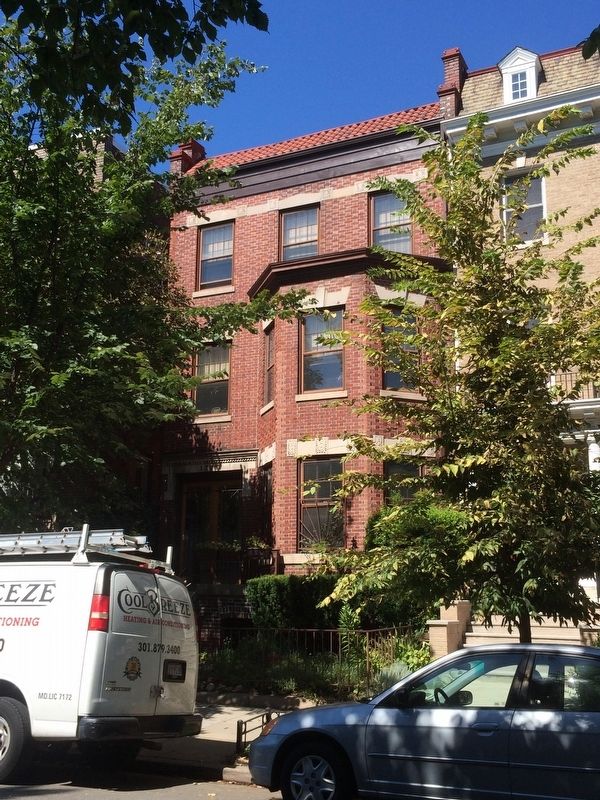
Photographed By J. Makali Bruton, September 14, 2016
4. Corrigan v. Buckle site at 1727 S Street, NW
Irene Corrigan, owner of this property, attempted in 1922 to sell her house to Helen Curtis and her husband Dr. Arthur Curtis, both African American. One year earlier, the majority of the block's white residents, including Corrigan, had signed an agreement, or covenant, that they would not sell or rent their properties to African Americans. When Corrigan tried to sell her house to the Curtises, a neighbor asked the District Supreme Court to enforce the covenant and prevent the sale. The court agreed. Corrigan and Curtis took their appeal to the U.S. Supreme Court, which in 1926 declined to hear the case on the grounds that the constitutional amendments cited by Corrigan and Curtis, including the 14th Amendment that prohibited race-based discrimination, were applicable to action by states only, not by individuals. The lower court ruling stood, and Corrigan could not sell to Curtis.
Covenants were enforced legally for the next 20-plus years. Then Charles Hamilton Houston, who happened to live in this same block at 1744 S Street, and white lawyer Phineas Indritz filed Hurd v. Hodge, again challenging the right of homeowners to enforce race-restrictive covenants. The house in question in this case was located in the 100 block of Bryant Street, NW, and had been purchased by James M. Hodge. This time, in 1948, the Supreme Court ruled that the covenants no longer could be enforced in courts of law. (courtesy of Cultural Tourism DC)
Covenants were enforced legally for the next 20-plus years. Then Charles Hamilton Houston, who happened to live in this same block at 1744 S Street, and white lawyer Phineas Indritz filed Hurd v. Hodge, again challenging the right of homeowners to enforce race-restrictive covenants. The house in question in this case was located in the 100 block of Bryant Street, NW, and had been purchased by James M. Hodge. This time, in 1948, the Supreme Court ruled that the covenants no longer could be enforced in courts of law. (courtesy of Cultural Tourism DC)
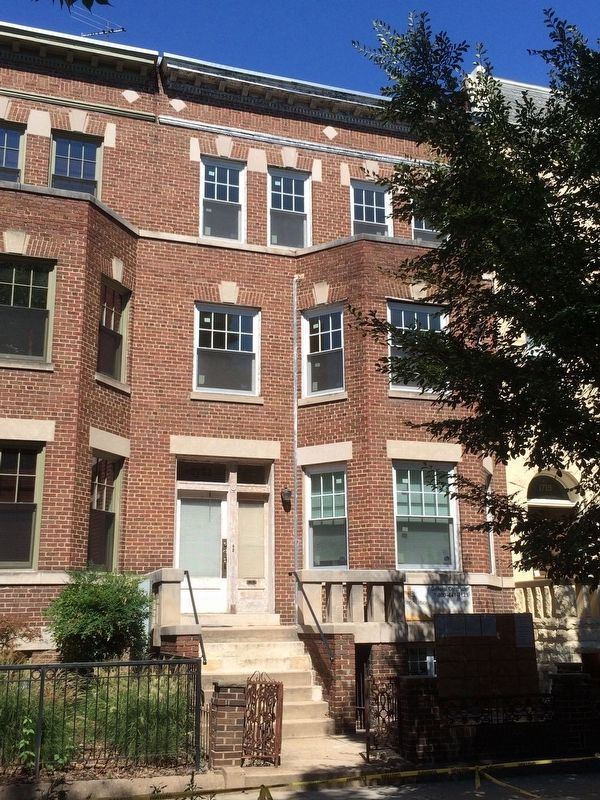
Photographed By J. Makali Bruton, September 14, 2016
5. Brig. Gen. Benjamin O. Davis Residence at 1721 S Street, NW
Benjamin O. Davis, Sr. (1877-1970), one of the most important military professionals of the 19th and 20th centuries, was the first black general in the U.S. Army and the U.S. Armed Forces. A native Washingtonian, Davis attended M Street High School and Howard University. His first tour of duty for the U.S. Army took him to the Philippines during the Spanish-American War in 1898. Davis moved up through the ranks, spending time as a professor of military science at Wilberforce and Tuskegee Universities and for the Ohio and New York National Guards. Davis worked in a number of positions for the armed forces over a span of 50 years before retiring in 1948, the same year that President Truman issued Executive Order 9981 barring segregation in the armed forces. He received the Bronze Star Medal and the Distinguished Service Medal in recognition of his service as an inspector of troop units in the field and as special War Department consultant on matters pertaining to African American troops. He moved to this house in 1948.
Davis and his wife Elnora Davis raised a son who followed in his father's footsteps. Lt. Gen. Benjamin O. Davis, Jr. (1912-2002), born in Washington, stands out as the nation's second African American general officer and the U.S. Air Force's first African American general. He was also a commander of the Tuskegee Airmen, which formed the core of the U.S. Army's all-black 99th Pursuit Squadron during World War II. Under Davis, the squadron's 332d Fighter Group flew more than 15,000 sorties against the Luftwaffe, shot down 111 enemy aircraft, destroyed another 150 on the ground, and lost only 66 of their own aircraft. Davis retired in 1970 and later served as assistant secretary of transportation for environment, safety, and consumer affairs under President Nixon.
Both men had to endure the racist and segregationist practices of the white-run armed forces and both, in overt and subtle ways, worked to eradicate injustice. They are interred at Arlington National Cemetery. (courtesy Cultural Tourism DC).
Davis and his wife Elnora Davis raised a son who followed in his father's footsteps. Lt. Gen. Benjamin O. Davis, Jr. (1912-2002), born in Washington, stands out as the nation's second African American general officer and the U.S. Air Force's first African American general. He was also a commander of the Tuskegee Airmen, which formed the core of the U.S. Army's all-black 99th Pursuit Squadron during World War II. Under Davis, the squadron's 332d Fighter Group flew more than 15,000 sorties against the Luftwaffe, shot down 111 enemy aircraft, destroyed another 150 on the ground, and lost only 66 of their own aircraft. Davis retired in 1970 and later served as assistant secretary of transportation for environment, safety, and consumer affairs under President Nixon.
Both men had to endure the racist and segregationist practices of the white-run armed forces and both, in overt and subtle ways, worked to eradicate injustice. They are interred at Arlington National Cemetery. (courtesy Cultural Tourism DC).
Credits. This page was last revised on January 30, 2023. It was originally submitted on September 14, 2016, by J. Makali Bruton of Accra, Ghana. This page has been viewed 617 times since then and 68 times this year. Photos: 1, 2, 3, 4, 5. submitted on September 14, 2016, by J. Makali Bruton of Accra, Ghana.
